“Baltimore, the Liverpool of America”

In Which Trillion Was Right All Along
A blog post by Collections Manager Joanna Church. To read more posts by Joanna click HERE.
As always, it’s the odd little hidden gems in the collection that warm a registrar’s heart. I recently happened upon this book, and – being a sucker for municipal encomiums of the past – I took a closer look. Here for you today we have a Souvenir of Baltimore, printed in 1898 by A. Hoen & Co. of Baltimore, “compiled expressly for the American Pharmaceutical Association” in dedication “to its members in commemoration of the forty-sixth annual meeting, held August, 1898” in Baltimore.
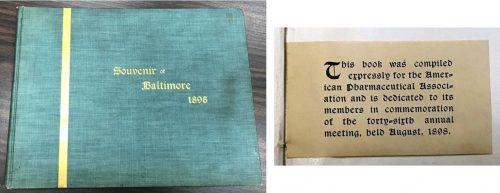
Alas, the Jewish community is not featured with any prominence in this volume, in the photographs that make up the bulk of the book, the history of the city, or the contemporary statistics and achievements. We can’t be ignored altogether, of course:
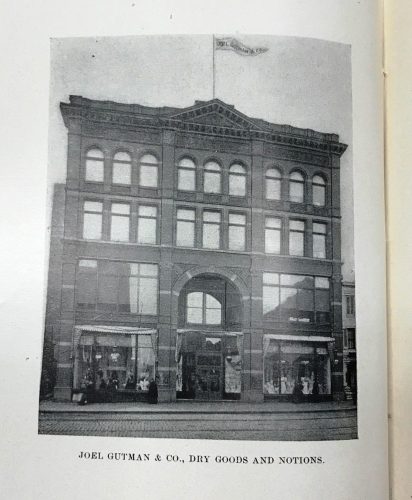
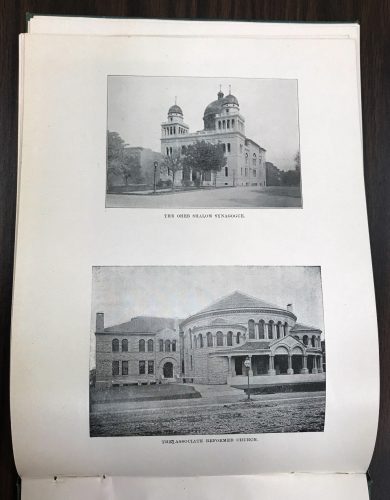
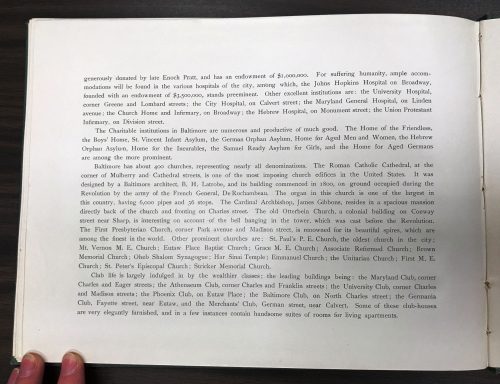
We’re also represented in a less obvious – but still financially important – way, as the concluding statistics touting “the leading industrial and distributive trades” in the city include $15,000,000 for “Manufactured Clothing,” and $6,000,000 each for “Shirts, Drawers, and Overalls” and “Straw Hats” – all trades in which the Jewish community was quite active, if not indeed the leaders.
To me, though, the most striking thing about the book is this proclamation on the first page:
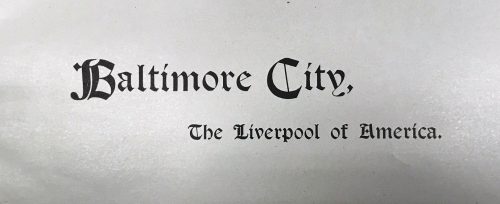
Well okay, then. Perhaps this mostly struck me as peculiar because I had just, less than an hour previously, been talking about Liverpool with a former resident. And I know only a very few facts about the city of Liverpool, most of which have to do with either music or football … neither of which topics bring Baltimore immediately to my mind (“Baltimore Hit Parade” and the Ravens notwithstanding). It’s clear that this comparison would have meant something to its readers in 1898, but this book never actually explains it.
Thus, as always, to the internet we go! It turns out this was not just a one-off comparison. Our friends at A. Hoen & Co. had earlier published a map of the city, with the same title, as a newspaper supplement in 1872; the Mercantile Advancement Company published a 231 page book, Baltimore: The Gateway to the South, the Liverpool of America in 1898; and in 1894 a local newspaper doubled-up on the city’s nicknames, publishing a two-volume celebration titled The Monumental City, the Liverpool of America: A Souvenir of the 121st Anniversary of the Baltimore American.

More helpful, however, is this April 1875 article from Scribner’s Monthly (“An Illustrated Monthly for the People”) which makes the comparison more explicit, focusing on Baltimore’s industrial strengths, rapid rise in population, and “remarkable development of its terminal facilities” (i.e., the harbor and the railroads). Not only did that make us the Liverpool of America, it apparently made us “the fashion.”
I didn’t find the phrase used in the 20th century (at least not on an internet search), but in some ways the comparison stayed true, if progressively less flattering, as industry dwindled and each city’s future become rather less rosy … and then, in the late 20th century, an arts scene helped bring each city back to life. But here’s Trillion to talk more knowledgably about it!
I lived in Liverpool for about ten years, initially for University but I stayed when I met my husband. It is a wonderful city, with a fascinating history and amazing people. If you ever have a chance to visit Liverpool I would highly recommend taking the opportunity, you don’t need to love The Beatles, but you will hear them almost everywhere you go in the city. I didn’t anticipate finding similarities between the two cities but as soon as I arrived in Baltimore they quickly became apparent. The biggest similarity is history, both cities were important ports meaning there was a huge amount of wealth at one point and an international community. The impact of this can especially be seen in architecture, both have some amazing historic buildings highlighting their status as international cities, plus they both have wonderful museum collections gathered from around the world. Adding to this however both cities experienced trouble during the twentieth century and have seen this impact the way in which they are viewed nationally and internationally. It seems though that the local communities of both have come together to develop a thriving arts and culture scene that attracts visitors from around the world, bringing back just a little of that former glory.
The cities have their differences, but I frequently find a certain comfort in the similarities, making Baltimore feel not quite so far away from home. ~Trillion
